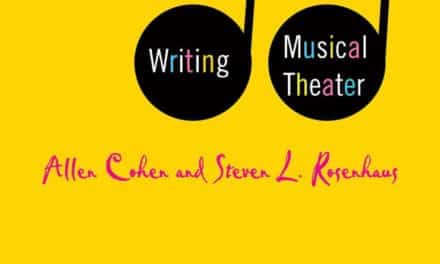
We can all use a bit of expert advice from time to time. But, unless you’re as fortunate as a young Stephen Sondheim and live next door to the Hammersteins, you’re going to have to hit the books. Thanks to the internet, finding even out-of-print publications has become fairly easy. The following is our loosely-organized, roughly-alphabetical, highly-arbitrary and ever-expanding guide to prose by the Pros.
Getting Started: Choosing the Right Project
Where does an idea for a musical come from?
How do you know if it’s a good idea?
“It’s hard enough to write a musical that you love. If you don’t love it, it’s impossible.”
– Oscar Hammerstein
The Art Of The American Musical: Conversations With The Creators
- Lynn Ahrens spends a lot of time in bookstores and at the movies (pg. 11).
- Lynn Ahrens credits her husband with suggesting Bedazzled (pg. 5).
- Jason Robert Brown explains how songs written for the cabaret acts of his friends became Songs for a New World (pg. 28).
- Fred Ebb chooses something that interests him, even if no one but John Kander agrees (pg. 103).
- Sheldon Harnick finds Fiddler on the Roof by reading a novel that he didn’t want to adapt (pg. 85).
- Arthur Laurents is inspired to write Hallelujah, Baby! for Lena Horne “but, she isn’t interested” (pg. 133).
- Harold Prince plays hardball with Warner Brothers for the rights to The Petrified Prince (?!) (pg. 184).
- Tommy Tune credits his insomnia for keeping him up late enough to see the film Grand Hotel on television (pg. 250).
- John Weidman turns to his major at Harvard for Pacific Overtures (pg. 261).
Notes on Broadway: Intimate Conversations With Broadway's Greatest Songwriters
- Leonard Bernstein touches on the controversy behind adapting Shakespeare into West Side Story (pg. 14).
- Jerry Bock talks about deciding to adapt three short stories for The Apple Tree (pg. 32).
- Adolph Green complains that it’s “agony” to find a new project(pg. 67).
- Gretchen Cryer shows how real life led her to write I’m Getting My Act Together (pg. 80).
- Sammy Cahn advises keeping it simple (pg. 44).
- William Finn credits desperation as the inspiration for Falsettos (pg. 114).
- Micki Grant hopes for involving subject matter (pg. 127).
- Marvin Hamlisch found A Chorus Line at the rehearsal hall (pg. 143).
- Charles Strouse goes looking for one book and ends up finding another (pg. 278).
- Sheldon Harnick admits to not knowing what a “surefire subject” is anymore (pg. 168).
- Henry Krieger turns an ‘After-School Special’ into The Tap Dance Kid (pg. 212).
- Allen Jay Lerner discovers Camelot in a book review (pg. 224).
- Tim Rice hears about Eva Peron on the radio (pg. 233).
- Mary Rodgers doesn’t care for “abstract stuff” (pg. 248).
- Carol Bayer Sager seeks “something that people can identify with” (pg. 254).
I Got the Show Right Here : The Amazing True Story of How an Obscure Brooklyn Horn Player Became the Last Great Broadway Showman
- Cy Feuer figure out how to turn an unpromising play into the musical hit Where’s Charley (pg. 80).
- Cy Feuer reveals how a “weak but tempting” early adaptation of How to Succeed became a commercial success (pg. 220).
- Cy Feuer says that a casting concept (Sid Caesar playing multiple roles) sold him on Little Me (pg. 223).
Making Musicals: An Informal Introduction to the World of Musical Theater
- Tom Jones gives advice on finding “a property” (pg. 92).
- Tom Jones suggests identifying “the problem” that needs to be solved before a promising property can become a musical (pg. 96).
Everything Was Possible: The Birth of the Musical Follies
- Ted Chapin shows how a photograph in Life Magazine turned “The Girls Upstairs” into Follies (pg. 7).
The off-Broadway experience
- Jerry Herman trusts his instincts (pg. 142).
- Jerry Herman gets experimental with Madame Aphrodite (pg. 148).
Ever After: The Last Years of Musical Theater and Beyond
- Barry Singer reveals how Jonathan Larson responded to being denied the rights to adapt ‘1984’ (pg. 101).
























